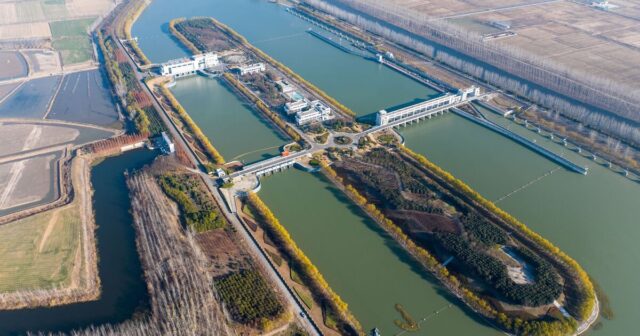A new Chinese megaproject, considered to be the brainchild of the country’s revolutionary dictator Mao Zedong, aims to solve an age-old problem of water scarcity in the north of the country.
The South-North Water Transfer Project is a multi-decade infrastructure megaproject that aims to channel 44.8 billion cubic metres of fresh water each year from the Yangtze River in southern China to the more arid and industrialised north through three canal systems. It is the largest project of its kind ever undertaken.
The project is believed to be more than 50 years in the planning, with work commencing in 2003, although completion is not expected for another two decades.
With an estimated £59 billion spent on the project already according to world affairs, it is on course to be one of the most expensive engineering projects in human history.
The project will see three routes built, to connect China’s four main rivers Yangtze, Yellow River, Huaihe, and Haihe, spread out over the country’s vast land mass and divert water northwards.
The Eastern Route Project (ERP) is an upgrade to the Grand Canal on the Yangtze River and will play a small part in the overall delivery of water to the north.
Water from the Yangtze River will be drawn into the canal in Jiangdu where an existing, giant pumping station will then pump the water onwards along the Grand Canal and through a tunnel under the Yellow River and down an aqueduct to reservoirs near Tianjin.
The central route, known as the Grand Aqueduct, runs from the Danjiangkou Reservoir on the Han River, a tributary of the Yangtze, to Beijing.
This project involved raising the height of the Danjiangkou Dam by increasing the dam’s crest elevation from 162 metres to 176.6 metres above sea level, to allow the water level in the reservoir to rise by over 10 metres to permit the flow into the water diversion canal downhill.
This route crosses the North China Plain. The canal was constructed to create a continuous downhill flow so that pumping stations were not required.
Construction on the central route began in 2004. In 2008, the 190-mile-long northern stretch of the central route was completed at a cost of $2 billion (£1.5 billion).
There are long-standing plans to divert about 200 km3/year of water from the upstream sections of six rivers in southwestern China, including the Mekong and Tarlung Zangbp to the Yangtze and Yellow rivers and ultimately to the dry areas of northern China through a system of reservoirs, tunnels, and natural rivers in the course known as the west route.
The displacement of hundreds of thousands of residents caused by this project is a source of concern. As the region is prone to earthquakes, there are also concerns about the possible extensive damage to the scheme a tremor could create. This mega project has also raised alarms about ecosystem disruption and habitat loss.
In 2013, Radio Free Asia reported that fish farmers on Dongping Lake, on the project’s eastern route, claimed that the polluted Yangtze River water entering the lake was killing their fish.





